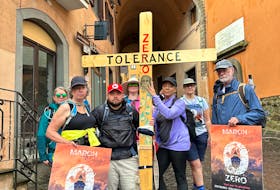The rare plants found on the Northern Peninsula’s limestone barrens have received a lot of attention in the past, but Corner Brook is hoping to now shed some light on some of its own special flora.
On Monday, the city signed a Municipal Habitat Stewardship Agreement with the provincial government that will help protect two such plants found within the city.
Both plants are found in the Wild Cove fen, a wetland area located just south of the landfill site on Route 440 to the north shore of the Bay of Islands.
The fen contains the only known provincial populations of Rattlesnake Root, while the Northern Bog Aster is only known to exist in the Wild Cove fen and in the Balls Pond area, which is nearly 15 kilometres further northeast of the city boundary.
The agreement signed Monday by Mayor Jim Parsons and Fisheries and Land Resources Minister Gerry Byrne does not require any funding. Rather, it is simply a designation to protect the area from any future development in an effort to maintain the existence of these plants listed by the province as endangered species.
Jonathan Sharpe, a senior wildlife biologist with the Department of Fisheries and Land Resources, signed the agreement as a witness. He has worked on many other of the 42 such agreements now in place across the province, but is particularly excited about this one in his hometown of Corner Brook.
The agreement does not mean people are forbidden from going near the site. In fact, people are encouraged to visit the fen and admire the rare plants without disturbing them or the habitat in which they are found.
“This is a species-at-risk area and it’s not overly accessible, but we don’t view these as no-touch areas,” said Sharpe. “They are areas we want people to get out in and enjoy them and be part of nature and learn about it.”
Sharpe said each community tends to come up with its own way to work with the site. In some areas, that comes in the form of a committee that goes about various projects in support of the agreement.
Sharpe said he is interested to see what the imaginations of Corner Brookers come up with for protecting this area.
The details
- Both the Rattlesnake Root and the Northern Bog Aster, known to only exist in the Wild Cove fen and in the Balls Pond area of western Newfoundland, are listed provincially as endangered, or facing possible extirpation.
- The Wild Cove fen is a wetland located just south of the Wild Cove waste transfer station that has a drainage system extending along Wild Cove Brook under Route 440 and into Wild Cove.
- The City of Corner Brook is the 42nd community in Newfoundland and Labrador to enter into a Municipal Habitat Stewardship Agreement with the provincial government
- The first step of incorporating the Wild Cove fen into the City of Corner Brook’s municipal plan has already been taken by the city, as this area is listed as an environmental protection zone.
- The second step of the process is community engagement, usually done by a committee that fosters stewardship initiatives such as interpretive signage, access for visitation, clean-up efforts, bird blinds and other wildlife habitat enhancements.
Source: Department of Fisheries and Land Resources









